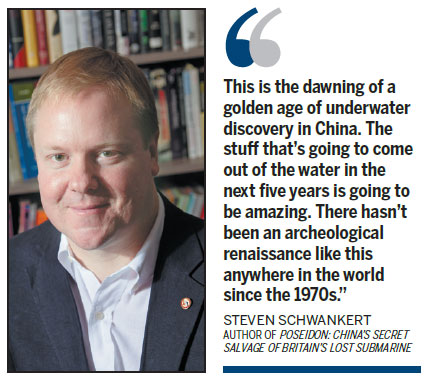Raising poseidon, changing history
Updated: 2014-03-25 07:23
By Matt Hodges (China Daily)
|
|||||||||||
US author discusses a sunken British submarine, the historic self-rescue effort and China's salvaging of the past. Matt Hodges reports in Shanghai.
It sounds like the plot of an underwater thriller: A British submarine collides with a Chinese cargo ship off Weihai, Shandong province, in 1931 and sinks, prompting some of the crew to risk a potentially suicidal dash to the surface using experimental proto-scuba gear.
Four decades later, the government orders the Shanghai salvage bureau to dig up the wreckage from the Bohai Sea for unknown reasons, a move that remains hidden from the rest of the world for the next 30 years. Weihai served as a British colonial enclave until 1930.
|
Steven Schwankert's passion for diving led himto stumble upon the story of a sunken British submarine and bring it to life in his Poseidon: China's Secret Salvage of Britain's Lost Submarine. Photos Provided to China Daily |
The full details of this gripping story are painstakingly researched and colorfully brought to life in Steven Schwankert's Poseidon: China's Secret Salvage of Britain's Lost Submarine, published in Hong Kong in 2013.
It pairs well with the 2013 documentary The Poseidon Project by British brothers Arthur and Luther Jones, which casts Schwankert and his project in a starring role.
"(The book) took me on a six- to seven-year journey, with lots of twists and turns," Schwankert says in a talk at M on the Bund as part of the Shanghai International Literary Festival.
Six of the 26 trapped crewmen survived, including one of two Chinese mates. The other, who reportedly panicked, failed to make it to the surface.
His body was never discovered.
The story made history as it was the first time downed submariners had successfully escaped using the new Davis Submerged Escape Apparatus, which led to its widespread adoption by the Royal Navy.
The old China hand, who serves as a Fellow of the Royal Geographical Society and the Asia Chapter Chair of The Explorer's Club, described how he brought the story to the attention of the British Navy en route to researching his book.
He also discussed diving submerged parts of the Great Wall - Schwankert founded SinoScuba, Beijing's first professional scuba diving operator, in 2003. He says China has a growing interest in rediscovering its underwater heritage.
"This is the dawning of a golden age of underwater discovery in China," he says. "The stuff that's going to come out of the water in the next five years is going to be amazing. There hasn't been an archeological renaissance like this anywhere in the world since the 1970s."
The findings could rewrite history. "My guess is that local trade routes all go back way longer than we've estimated. It's only a matter of time before we find an Arabian or African ship in the South China Sea," says Schwankert, an entertaining orator and meticulous researcher with a penchant for wearing his wristwatch back to front, as divers often do with their depth gauges.
"That will happen, and I think people will be surprised at the number of discoveries made," he adds.
The South China Sea contains a treasure trove of wrecks for divers to explore, with highlights including Britain's HMS Repulse and HMS Prince of Wales. But it is an Italian liner at the bottom of the North Atlantic, the Andrea Doria, which sank just south of Nantucket, Massachusetts in 1956, that has been dubbed "the Everest of diving" at 70 meters down. Alvin Moscow's book Collision Course explains its tragic story in detail.
Schwankert says China can expect to salvage hordes of unspoiled pottery, porcelain, jewelry and silver from the Tang (AD 618-907) to Qing (1644-1911) dynasties, "but probably not much gold".
"It will probably be very different from the Pirates of the Caribbean stuff coming out of America - no treasure chests or pieces-of-eight - but no less interesting," he says.
"I hope I can play just a teeny, tiny role in China's rediscovery of its recent maritime heritage," adds the New Jersey native, who believes such foraging can be used to shore up China's territorial claims.
President Xi Jinping called on ASEAN members to cooperate on building a new "maritime silk road" during his first official swing through Southeast Asia last October. He issued the remarks in Indonesia amid a climate of simmering territorial disputes in Asia, notably between China and Japan over the Diaoyu Islands in the East China Sea.
"We're tightly following the 12th Five-Year Plan to carry out underwater archeology work regularly to protect China's heritage and reclaim its maritime history," says Jiang Bo, a director at the State Administration of Cultural Heritage Center for Underwater Cultural Heritage in Beijing.
In 2013, the center successfully ferried the Nanhai 1, a Song Dynasty (960-1279) vessel, to the Guangdong Maritime Silk Road Museum for storage. Raised from the ocean floor south of the province in 2007, it ranks as the largest sunken cargo vessel discovered in Chinese waters to date.
China also reopened the Baihe - liang Underwater Museum at 40 meters below sea level in 2012 to protect a reef in the Yangtze River near Chongqing and is now at work on a next-generation underwater exploration boat, Jiang says.
It was Schwankert's passion for diving that led him to stumble upon the Poseidon story. He led the first scientific expedition to dive Mongolia's Lake Khovsgol in 2007, where his team found two wooden shipwrecks dating back to the early 20th century.
He says China offers "wonderful" opportunities for divers, despite its paucity of tropical marine life and its chilly underwater climes. Highlights include a 1,000-year-old city submerged in Zhejiang's Qiandaohu (Thousand-island lake) and parts of the Great Wall.
"The best thing diving in China offers is history," he says. "You can't dive the (Egyptian) pyramids, but you can dive the Great Wall, and it's a much more intimate experience than hiking it. You're not focused on the horizon, you look at the craftsmanship. And you get a 360-degree view - you can be on top of it, next to it, and sometimes even underneath it."
When asked whether China's underwater-salvaging skills and technology could play a role in helping or retrieve Malaysian Airlines flight MH370, he would not be drawn.
But Schwankert used the story of the Nanhai 1 to illustrate how the nation is experimenting with novel approaches in this field.
"They used what I call the Siberian woolly mammoth technique to keep it structurally intact," he says with a trademark quip, adding that the team carved the frozen wreck into four-ton blocks of ice and ferried them inland to sit in a pool of water in southern China.
He is working on another missing piece of history involving a sunken ship off China's coast for his next book.
Contact the writer at matthewhodges@chinadaily.com.cn.

(China Daily 03/25/2014 page22)
Today's Top News
Xi pledges to bolster nuclear security
Kremlin 'ready' to work with G7
Beijing among most polluted areas
China eyes 'Cathay' tulip import
President takes detour on state visit to France
US mudslide death toll climbs to 14, 176 missing
Courier, customer brawl in Chongqing
Tibet Airlines to open four new routes
Hot Topics
Lunar probe , China growth forecasts, Emission rules get tougher, China seen through 'colored lens', International board,
Editor's Picks

|

|

|

|

|

|






